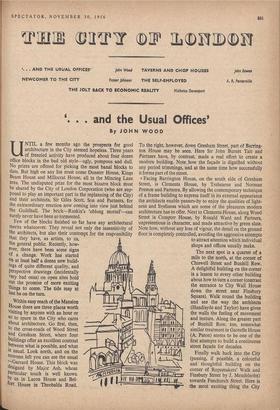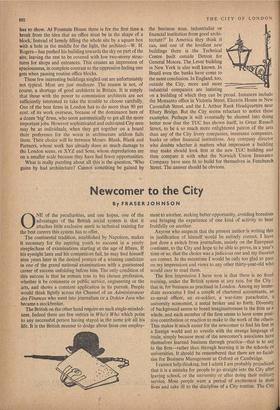11 1 1E1 LEI 1 B Dr
. . AND THE USUAL OFFICES' John Wood NEWCOMER TO THE CITY Fraser Johnson TAVERNS AND CHOP HOUSES John Bowen THE SELF-EMPLOYED A. R. Penterville THE JOLT BACK TO ECONOMIC REALITY Nicholas Davenport
`. . . and the Usual Offices'
By JOHN WOOD UNTIL a few months ago the prospects for good architecture in the City seemed hopeless. Three years of frenzied activity have produced about four dozen office blocks in the bad old style—ugly, pompous and dull. No prizes -are offered for picking the most banal blocks to date. But high on any list must come Dunster House, Kings Beam House and Millocrat House, all in the Mincing Lane area. The undisputed prize for the most bizarre block must be shared by the City of London Corporation (who are sup- posed to play an important part in the replanning of the City) and their architects, Sir Giles Scott, Son and Partners, for the extraordinary erection now coming into view just behind the Guildhall. The brick—Ruskin's 'oblong morsel'—can surely never have been so tormented.
Within easy reach of the Mansion House there are three places worth visiting by anyone with an hour or so to spare in the City who cares about architecture. Go first, then, to the cross-roads of Wood Street and Gresham Street, where four buildings offer an excellent contrast between what is possible, and what Is usual. Look north, and on the extreme left you can see the usual --Garrard House. This block was designed by Major Ash, whose Particular touch is well known to us in Lacon House and Bel- ton House in Theobalds Road. To the right, however, down Gresham Street, part of Barring- ton House may be seen. Here Sir John Burnet Tait- and Partners have, by contrast, made a real effort to create a modern building. Note how the facade is dignified without any period trimmings, and at the same time how successfully it forms part of the street.
• Facing Barrington House, on the south side of Gresham Street, is Clements House, by Trehearne and Norman Preston and Partners. By allowing the contemporary technique of a frame building to express itself in its external appearance the architects enable passers-by to enjoy the qualities of light- ness and liyeliness which are some of the pleasures modern architecture has to offer. Next to Clements II-louse, along Wood Street is Compter House, by Ronald Ward and Partners, unpretentious in character, and made attractive by green slate. Note how, without any loss of vigour, the detail on the ground floor is completely controlled, avoiding the aggressive attempts to attract attention which individual shops and offices usually make.
The next spot is a quarter of a mile to the north, at the corner of Chiswell Street and Bunhill Row. A delightful building on the corner is a lesson to every other building about how to turn a corner (contrast the entrance to City Wall House down the street near Finsbury Square). Walk round the building and see the way the architects (Handisyde and Taylor) have given the walls the feeling of movement and texture. Along the greater part of Bunhill Row, too, somewhat similar treatment in Gavrelle House (A. Paton) seems to be one of the first attempts to build a continuous street facade for decades.
Finally walk back into the City (passing, if possible, a colourful and thoughtful building on the corner of Ropemakers' Walk and Finsbury Street by J. Mendelsohn) towards Fenchurch Street. Here is the most exciting thing the City has to show. At Fountain House there is for the first time a break from the idea that an office must be in the shape of a block. Instead of lamely filling the whole site by a square box with a hole in the middle for the light, the architect—W. H. Rogers—has pushed his building towards the sky on part of the site, leaving the rest to be covered with low two-storey struc- tures for shops and entrances. This creates an impression of spaciousness, in complete contrast to the oppressive feeling one gets when passing routine office blocks.
These few interesting buildings singled out are unfortunately not typical. Most are just mediocre. The reason is not, of course, a shortage of good architects in Britain. It is simply that those with the power to commission architects are not sufficiently interested to take the trouble to choose carefully. One of the best firms in London has to do more than 90 per cent. of its work overseas, because of the dominance here of a dozen 'big' firms, who seem automatically to get all the more important jobs. However sophisticated and cultivated City men may be as individuals, when they get together on a board their preference for the worst in architecture seldom fails them. Their choice will lie between Messrs. Blank. Blank and Partners, whose work has already done so much damage to the London scene, or XYZ and Sons, whose depredations are on a smaller scale because they have had fewer opportunities.
What is really puzzling about all this is the question, 'Who gains by bad architecture? Cannot something be gained by the business man, industrialist or financial institution from good archi- tecture?' In America they think it can, and one of the loveliest new buildings there is the Technical Centre built outside Detroit for General Motors. The. Lever building in New York is also well known. In Brazil even the banks have come to the same conclusion. In England, too, outside the City, more and more industrial companies are insisting on a building of which they can be proud. Instances include the Monsanto office in Victoria Street, Electrin House in New Cavendish Street, and the J. Arthur Rank Headquarters near Ebury Bridge. But the City seems reluctant to notice these examples. Perhaps it will eventually be shamed into doing better now that the TUC has shown itself, in Great Russell Street, to be a so much more enlightened patron of the arts than any of the City livery companies, insurance companies, banks or other financial institutions. Any company director who doubts whether it matters what impression a building may make should look first at the new TUC building and then compare it with what the Norwich Union Insurance Company have seen fit .to build for themselves in Fenchurch Street. The answer should be obvious.



















































 Previous page
Previous page